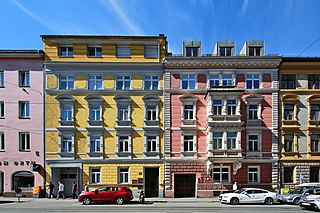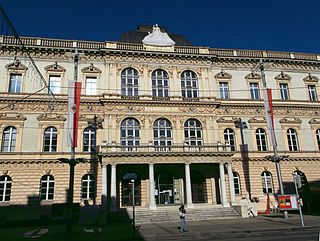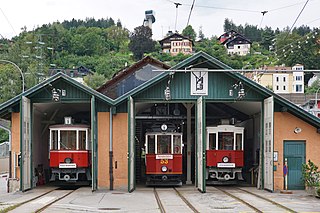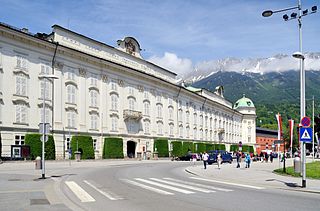
The Armoury (German : Zeughaus) in Innsbruck, Austria, is a former military arsenal that is now a museum. It lies in the Innsbruck quarter of Dreiheiligen.

The Armoury (German : Zeughaus) in Innsbruck, Austria, is a former military arsenal that is now a museum. It lies in the Innsbruck quarter of Dreiheiligen.

Maximilian I had the Armoury built from 1500 to 1505 on the Sill which was then in front of the gates of the town. It consists of two 80 x 10 m, two-storey wings and two narrow gatehouses and blocks that surround a large inner courtyard. Materiel for war was stored here and, around the Armoury, were subsidiary buildings. As well as cannon, many small arms were also stored here.
In 1503 a brass foundry was built in Mühlau. Crucial to the choice of location was the site of the city of Innsbruck as a transport hub and the thriving copper mines of Tyrol, which had given rise to a flourishing arms industry in Innsbruck.
In 1503 housed the armory about 150 guns
Until the end of the monarchy in 1918 the place was still in use as the Armoury Barracks (Zeughauskaserne). It was restored in 1964/1969 and opened in 1973 as the Tyrolean State History Museum (Tiroler Landeskundliches Museum).

Today a branch of the Tyrolean State Museum is housed in the Armoury. It offers a historical and technical collection of the cultural history of Tyrol from the early period to its most recent history.
The museum puts on special exhibitions that change periodically. In summer the inner courtyard hosts open-air cinemas and concerts.

Innsbruck is the capital of Tyrol and the fifth-largest city in Austria. On the River Inn, at its junction with the Wipp Valley, which provides access to the Brenner Pass 30 km (19 mi) to the south, it had a population of 132,493 in 2018.

Tyrol is an Austrian federal state. It comprises the Austrian part of the historical Princely County of Tyrol. It is a constituent part of the present-day Euroregion Tyrol–South Tyrol–Trentino. The capital of Tyrol is Innsbruck.

The Zeughaus is a listed building and the oldest structure on Unter den Linden boulevard in the historic centre of Berlin. Erected from 1695 to 1706 according to plans by Johann Arnold Nering, Martin Grünberg, Andreas Schlüter and Jean de Bodt in Baroque style, it was later converted into a Prussian Hall of Fame. Damaged during the Allied bombing in World War II, it was rebuilt from 1949 to 1967 as part of the Forum Fridericianum. Since 2003, it has been home to the Deutsches Historisches Museum. Since June 2021 it is closed for necessary renovations and for the renewal of the Permanent Exhibition probably until the end of 2025.

The Goldenes Dachl is a landmark structure located in the Old Town (Altstadt) section of Innsbruck, Austria. It is considered the city's most famous symbol. Completed in 1500, the roof was decorated with 2,657 fire-gilded copper tiles for Emperor Maximilian I to mark his wedding to Bianca Maria Sforza. The Emperor and his wife used the balcony to observe festivals, tournaments, and other events that took place in the square below.

The (Princely) County of Tyrol was an estate of the Holy Roman Empire established about 1140. After 1253, it was ruled by the House of Gorizia and from 1363 by the House of Habsburg. In 1804, the County of Tyrol, unified with the secularised prince-bishoprics of Trent and Brixen, became a crown land of the Austrian Empire. From 1867, it was a Cisleithanian crown land of Austria-Hungary.

The Grandmaster's Palace, officially known as The Palace, is a palace in Valletta, Malta. It was built between the 16th and 18th centuries as the palace of the Grand Master of the Order of St. John, who ruled Malta from 1530 to 1798, and was also known as the Magisterial Palace. When the knights were expelled by Napoleonic France, it became the National Palace. During the period of British rule beginning in 1800, it was the Governor's Palace.

Ambras Castle is a Renaissance castle and palace located in the hills above Innsbruck, Austria. Ambras Castle is 632 metres (2,073 ft) above sea level. Considered one of the most popular tourist attractions of the Tyrol, Ambras Castle was built in the 16th century on the spot of an earlier 10th-century castle, which became the seat of power for the Counts of Andechs. The cultural and historical importance of the castle is closely connected with Archduke Ferdinand II (1529–1595) and served as his family's residence from 1567 to 1595. Ferdinand was one of history's most prominent collectors of art. The princely sovereign of Tyrol, son of Emperor Ferdinand I, ordered that the medieval fortress at Ambras be turned into a Renaissance castle as a gift for his wife Philippine Welser. The cultured humanist from the House of Habsburg accommodated his world-famous collections in a museum: the collections, still in the Lower Castle built specifically for that museum's purpose, make Ambras Castle one of the oldest museums in the world.

Tyrol Castle, less commonly Tirol Castle is a castle in the comune (municipality) of Tirol near Merano, in the Burggrafenamt district of South Tyrol, Italy. It was the ancestral seat of the Counts of Tyrol and gave the whole Tyrol region its name.

Tratzberg Castle is a castle in Jenbach, Tyrol, Austria. Tratzberg Castle is located on a steep ridge above Jenbach in the Austrian part of Tyrol. It is an excellent example of palace architecture typical for the alpine parts of the Holy Roman Empire during the late Gothic and early Renaissance period. The castle was built in its present form in 1500 mostly by the brothers Veit-Jakob and Simon Tänzl. Today Tratzberg Castle is owned and inhabited by Count Ulrich Goëss-Enzenberg and his wife Katrin Goëss-Enzenberg. Tratzberg is also one of the best preserved castles in Austria, having many of its original furnishings and fittings.

The Tyrolean Rebellion is a name given to the resistance of militiamen, peasants, craftsmen and other civilians of the County of Tyrol led by Andreas Hofer supported by his wife Anna and a strategic council consisting of Josef Speckbacher, Peter Mayr, Capuchin Father Joachim Haspinger, Major Martin Teimer and Kajetan Sveth, against new legislation and a compulsory vaccination programme concerning smallpox ordered by King Maximilian I of Bavaria, followed by the military occupation of their homeland by troops organised and financed by Napoleon I of the First French Empire and Maximilian I. The broader military context is called the War of the Fifth Coalition.

The Tyrolean State Museum, also known as the Ferdinandeum after Archduke Ferdinand, is located in Innsbruck, Austria. It was founded in 1823 by the Tyrolean State Museum Ferdinandeum Society.

The Tyrolean Folk Art Museum is considered one of the finest regional heritage museums in Europe. Located next to the Hofkirche and across from the Hofburg in the Altstadt section of Innsbruck, Austria, the museum contains the most important collection of cultural artifacts from the Tyrol region.

The Tyrolean Museum Railways or Tiroler MuseumsBahnen (TMB) is a railway society in Austria whose aim is the preservation and/or documentation of the historically important branch lines (known as Localbahnen) and their rolling stock in the state of Tyrol.

The Alpine Club Museum in Innsbruck, Austria is a museum dedicated to the history of alpinism. Located in the Hofburg in the Altstadt section of the city, the museum is owned by the Austrian Alpine Club (ÖAV). In 2009, the museum was assessed as "excellent" for the Tyrolean and Austrian Museum Prizes, and was also nominated for the European Museum Prize in 2010.

The Museum of Tyrolean Farms is an open-air museum in Kramsach, Austria. As at 2009 the museum had around 30 historic farmsteads and other historic rural buildings as well as their associated barns, sheds, alms and storehouses.

Tyrol is a historical region in the Alps of Northern Italy and western Austria. The area was historically the core of the County of Tyrol, part of the Holy Roman Empire, Austrian Empire and Austria-Hungary, from its formation in the 12th century until 1919. In 1919, following World War I and the dissolution of Austria-Hungary, it was divided into two modern administrative parts through the Treaty of Saint-Germain-en-Laye:

The Hofburg is a former Habsburg palace in Innsbruck, Austria, and considered one of the three most significant cultural buildings in the country, along with the Hofburg Palace and Schönbrunn Palace in Vienna. The Hofburg is the main building of a large residential complex once used by the Habsburgs that still includes the Noblewomen's Collegiate Foundation, the Silver Chapel, the Hofkirche containing Emperor Maximilian's cenotaph and the Schwarzen Mandern, the Theological University, the Tyrolean Folk Art Museum, Innsbruck Cathedral, the Congress, and the Hofgarten.

Schlossberg Castle is a ruined toll castle in the municipality of Seefeld in Tirol in the district of Innsbruck Land in the Austrian state of Tyrol.

Hohenfreyberg Castle, together with Eisenberg Castle directly opposite, forms a castle group in the southern Allgäu that is visible from a long way off. It is located about four kilometres north of Pfronten in the county of Ostallgäu. The late mediaeval hilltop castle was abandoned during the Thirty Years' War and set on fire. From 1995 to 2006 the former aristocratic seat was comprehensively made safe and conserved as part of a closely observed "example of renovation".

The Tirol Panorama with the Museum of the Imperial Infantry or Tirol Panorama is a museum in Innsbruck in the Austrian state of Tyrol, which is mainly important because it houses the Innsbruck Giant Panorama Painting.